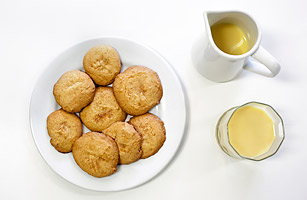
The vanilla drink is the color of new butter and tastes almost as good — creamy and sweet, like a liquid pudding. Next I try a pair of golden cookies, lightly touched with sugar — they're soft, chewy and filling. Last is a mustard yellow dipping sauce, tangy, that coats a handful of pretzels with a pleasant honeyed zing. Every reporting trip should be this tasty.
Each of the experimental food items I'm trying at a laboratory in South San Francisco has a nutritional profile that puts its supermarket counterpart to shame. The vanilla drink has 20% fewer calories and 75% less saturated fat than regular milk, while the dipping sauce has 74% fewer calories and 85% less overall fat than your average honey mustard dip. These are diet foods that taste sinfully good.
But the most unexpected thing about these foods is their secret ingredient: all-natural algae. That's right, the next generation of diet foods to reach your plate could be made from those single-celled organisms that float on stagnant ponds, courtesy of the South San Francisco biofuel startup Solazyme. "If you asked me as a food scientist if we could have reduced calories like this, I would have said no way," says Leslie Norris, the Solazyme chemist who concocted the delicious treats. "But we've done it."
It came as a surprise to Jonathan Wolfson, Solazyme's energetic CEO, as well. When Wolfson co-founded the company in 2003, the idea was to use cutting-edge biotechnology to create algae that could brew renewable, low-carbon biofuels. It's not a unique idea — there are dozens of similar algal biofuel startups around the country — but Solazyme was good at it. Its custom algae yielded biofuel that could be easily adapted to nearly any purpose, and could be dropped into existing car and truck engines without any modifications. Unlike ethanol derived from plants, Solazyme's feedstocks also didn't compete with food crops. Solazyme's tech was good enough that last year the U.S. Navy spent $8.5 million to order 20,000 gallons of its fuel, and Biofuels Digest, a daily energy newsletter, named it the hottest company in bioenergy. "We know we have technology that works," says Wolfson.
But in the middle of the worst recession in generations, great technology isn't enough to get ahead — especially when you're a small startup taking on the world's most profitable oil companies. Moreso than other clean-tech companies, biofuel startups face a daunting business hurdle: growing up from a pilot plant to truly commercial scale takes hundreds of millions of dollars in capital, which is hard to come by even in flush economic times. And the profit margin on a single gallon of biofuel is so slim, you can't start making money until you're selling it in large quantities. It's a Catch-22 that has entangled even the best startups, like Solazyme.
So Wolfson has looked to diversify Solazyme, finding other products it can churn out today at a higher profit margin and lower capital cost, while they continue to scale up their biofuel business. Which is how it came to be discovered that algae can be a building block for more than just green gasoline. Solazyme and its corporate partners are not only formulating cookies and milk, but they're already producing cosmetics that contain algal ingredients, including Altruest, a wrinkle-reducing skin cream. In early March, Solazyme signed a deal with the corporate giant Unilever to develop soap and other green personal care products derived from its algal oil. "Exploring sources of alternative natural oils is one of the most important aspects of our greater sustainable sourcing strategy and working with Solazyme's algal oils is an excellent fit," said Unilever executive Peter Gallagher in a statement.
But it's the diet foods that could represent an truly promising line of business for the clean-tech startup. The venture began when Norris, a food chemist, discovered that an algae-derived flour could be substituted for conventional flour to make a product similar to pita bread. And the lipid profile of the algae flour was strikingly similar to that of healthy olive oil. Using the algae-derived flour, Norris and her colleagues were able to make cookies, snack drinks, dipping sauces and more — all with less fat and calories and more protein than conventional food. "Fat delivers flavor in food, but this fat is healthy fat," says Norris. "For us a little fat delivers flavor very well, which is why this doesn't taste like diet food."
Solazyme isn't likely to sell its cookies or drinks directly; rather, it will manufacture the raw algae flour and sell it to food manufacturers. The challenge will be convincing consumers that algae will be worth eating. Although it's traditionally used as a food ingredient in other parts of the world, including Southeast Asia, American consumers may balk at the idea of eating cakes and cookies made with flour derived from, after all, pond scum. But if Solazyme can help make low-fat foods that really taste like dessert — and the items I tried definitely do — dieters will be lining up to eat their algae.